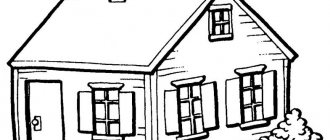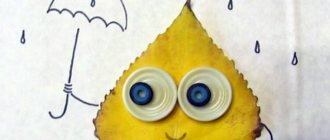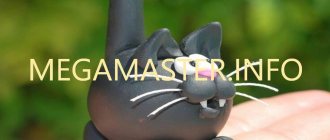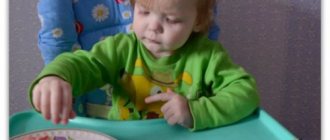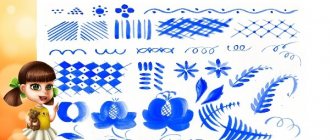Where to start learning
It is advisable to teach children to draw animals by mastering a simple pencil. It will create an outline of the image, which you can later happily color. In addition, children quickly get upset if something doesn’t work out for them. In the case of a simple pencil, it’s not difficult to fix everything: erase the missing element with an eraser and continue creating.
Which animal to choose for drawing
The first lesson is the most important, because you can teach a child to draw animals in a few minutes, provided that the object to be depicted is chosen correctly. You shouldn’t immediately suggest drawing a horse or a giraffe. The best option is a duckling, kitten or puppy. The images of these pets consist of a small number of elements, which minimizes the risk of failure in the lesson.
Interesting! Parents who decide to try to learn drawing techniques using step-by-step templates themselves rejoice like children, amazed at the result.
What you need for drawing
Any activity, be it drawing or morning exercises, should be started when the child himself wants it. It makes no sense to force someone to draw, because creativity is closely related to the state of the soul. For the first lessons you will need a minimum of tools:
- paper;
- a simple hard-soft pencil (marked TM or HB);
- eraser.
Note! It is preferable to take A4 paper or a classic sketchbook, but a notebook sheet will not work, the lines and cells in it will interfere with the baby, and the sheet will seem initially unclean to him.
Reading fairy tales in preparatory groups of kindergartens
It is recommended to give preference to a hard-soft pencil, because it is easiest to work with. Drawing with a hard stylus is inconvenient because it requires stronger pressure and the mark left behind is not bright. It will not be possible to erase it efficiently - a groove from the rod will remain on the paper. On the contrary, a soft lead does not require pressure at all, its mark is bright and clear, but when you try to erase the line, the eraser will smear the soft mark, leaving dark stains.
Motivating start to class
Drawing an animal figure in a characteristic pose or movement is a complex visual activity for preschool children. Creating a preliminary contour drawing from geometric shapes can be boring, practicing brush drawing techniques can be monotonous. To prevent children from losing interest in drawing, the teacher needs to use motivating material during the lesson.
Examples of using motivational material
| Type of motivating material | Examples of a motivating start to a lesson |
| Visual material: pictures and posters with images of animals, toys and figurines, slides, illustrations in books. | "Two greedy little bears." Pictures with illustrations of the fairy tale are attached to the magnetic board or the pictures are projected onto the screen. The children are invited to study the illustrations and arrange them in the order in which these scenes in the fairy tale are described. A conversation must be held based on the visual material: What animals are shown in the pictures? What features of the image of bear cubs and foxes did the guys notice? What colors and drawing techniques did the illustrator use? Which episode is shown most successfully and vividly, according to the students? |
| Reading poems, excerpts from fairy tales, nursery rhymes, riddles, proverbs. | "White bears". At the beginning of the lesson, the teacher asks the children an animal: Among the snow and ice it does not go hungry, it dives into cold water for fish, its thick white fur saves it, it warms it from frost. (Polar bear) The children are asked to remember what structural features of the polar bear’s body are, and then the teacher reads passages describing this animal from the Yukaghir fairy tales “Why does the polar bear have a black nose?”, “Who lives in the cold sea?” |
| Creating surprise moments and game situations. | "Sheep in the meadow." At the beginning of the lesson, a knock is heard, Kurochka (a junior teacher dressed in a suit) enters the group and tells the children that a Sheep lives in their village - a kind and beautiful animal. Hen describes the fur of a sheep: white, light, soft, in the form of rings and curls. But autumn came and the farmer cut the sheep’s wool so that the housewife could make yarn out of it and knit warm clothes for the winter. The Chicken reports that the Sheep does not feel sorry for the wool for the farm kids, but she is still sad for her beautiful fur coat. The chicken asks the guys for help, they decide that they can draw a sheep in a new fur coat. |
| Conducting a conversation on the topic of the lesson (with reference to the experience and ideas of the students). | "Journey to the Farm" The teacher hangs pictures of domestic animals on the board: cows, horses, rabbits, pigs, goats, sheep. The guys are asked the question: “Where can you see all these animals?” - in a village, village, on a farm. Before the children begin to study and discuss the poster “At the (Horse) Farm,” the teacher invites people to share stories and memories of those who have been on a farm, and also gives the opportunity to speak to those who have seen farms in films or read stories about them. . |
| Conducting physical education lessons, outdoor and didactic games on the topic of the lesson. | "Mustachioed - Striped". Outdoor games “Cat and Kittens”, “Vaska the Cat”. Physical education lessons with performing movements to the poems “Our Murka has kittens”, “All the kittens washed their paws”, etc. Didactic games: “Help the kitten untangle the ball”, “Find the differences in the pictures”, “Which cat does this shadow belong to”. |
Drawing up notes for an art lesson on the topic “Wild and Domestic Animals”
The duration of a drawing lesson for children 5–6 years old is no more than 25 minutes and consists of the following steps:
- Organizational moment 1 minute.
- Motivating start of the lesson 5-6 minutes.
- Discussion of the drawing algorithm 2–3 minutes.
- Practical work 10–11 minutes.
- Demonstration and discussion of drawings 2–3 minutes.
- Summing up 1 minute.
Outline of a drawing lesson (senior group) on the topic “Hedgehog” Author: Natalya Aleksandrovna Ashenkova
| Tasks | Learn to draw conclusions from the discussion during the conversation. Improve your ability to paint with a brush. Develop an interest in drawing. Form aesthetic taste. |
| Material | Illustrations depicting a hedgehog, photographs. Cut out silhouettes of hedgehogs, brushes, paper and paints for painting. Audio recording with forest music. |
| Preliminary work | Reading stories about forest animals, looking at illustrations in books. Learning poems about wild animals. Listening to audio recordings with sounds and voices of nature. Visit to the local history museum to get acquainted with wild animals. |
| Progress of the lesson | The children will learn the topic of the lesson after learning the answer to the riddle about the hedgehog. Listening to N. Charushin’s fairy tale “The Hedgehog”, discussing the content of the text: what features of the appearance of the hedgehog were described by the author. The teacher invites the children to draw a fairy tale hero. Studying the algorithm for drawing a hedgehog. Creating a pencil sketch. Performing a warm-up exercise with a brush. Practical work with paints. Break for the outdoor game “Hedgehog with Hedgehogs.” Children complete the drawings with small details. Demonstration and analysis of finished works. Summing up the lesson. |
Step-by-step schemes for kids
There are many simple patterns that make beautiful drawings; for children, animals are of more interest than household items or landscapes, so you should start with them.
A simple example of drawing a bird. Children love to feed the ducks on the ponds, any child would love to draw their own duck.
- The creative process begins with two ovals: the head and the torso, connected to each other by a short neck.
- Paws are drawn from the body down.
- On the duck's body, just below the middle, draw an arc representing a folded wing.
- Sharpen the edge of the oval from the tail side using an eraser. The tail is depicted by several almost parallel lines of short length
- A beak and an eye are drawn to the duck's head.
- The final touch is adding details in the form of drawing feathers throughout the body and wing of the bird.
- Now you can color it.
How to draw a duck
Elephant in squares
The elephant has large volumes, as far as practically every person knows what it looks like. We have already studied the image of an elephant, but now we need to consolidate the material we have learned. We will depict it on a sheet of paper in a cage, since this is how it is easier to reinforce the lesson.
How to draw by cells:
- Having prepared the album and equipped it with a pen, preferably a light pencil for beginners, we present a horizontal segment in the shape of an arc. At the top of the sketch we introduce small volume contours and draw a border identical to the first line, but downwards. As we get closer to the edge of the line, we move the segment in the opposite direction to get the bottom outline of the elephant's head.
- Starting from the top, we show large ears on the head in the shape of an uneven semi-oval. We then mark from the beginning of the ear to the front of the torso. Let's draw a horizontal line and complete the back of the elephant.
- We use a winding line at the back to show the tail of this animal. We finish drawing the forelimbs. Let's detail the ear.
- Now, use the arches on the head to place the eyes. We complete the mouth and detail it with teeth and tongue. We painted the main part of the mouth and the area above the trunk. We expanded the silhouette from above with drops of water that the elephant releases from its trunk.
- We paint the small lake on the right side with a blue pen. We paint the drops one color, but there should be white spots on them. Also, draw the edge of the pond.
- Then use a simple pencil to outline the outline of the body and other areas. Cover the brush on the tail. We shade the entire body with a light tone. Draw green grass under the elephant. We paint over it and paint the lake with a blue pencil. Tongue red or pink.
The elephant is drawn. Schoolchildren will even be able to figure it out on their own with simple work.
Classes for senior and preparatory groups
Schemes for drawing various animals for preschoolers are also used in master classes at preschool educational institutions. A popular technique is drawing with geometric shapes, from which not only insects are obtained, but also flowers, large animals and people. There is also a secret to using the number 8, which is demonstrated to children in open lessons in the form of presentations with templates. When teaching an algorithm for drawing a fly or a wasp, a figure eight is used, the horizontal arrangement of which helps to proportionally depict the head and abdomen of the insect.
More complex drawing algorithms
In the senior group of kindergarten, children already have a fairly broadly developed horizon, they think and fantasize more broadly, so at this age they can already learn more complex compositions.
More complex drawing techniques
These lessons pay more attention to detail, using shading, curved lines and irregular geometric shapes.
Using available templates and diagrams for drawing, you can teach your child to depict all representatives of the animal world, not only in our country. Many adults, trying to teach a child to create their own drawings, are so carried away by the diagrams that, to their surprise, they discover the hidden talent of an artist in themselves.
Source
Schemes and templates for children 4-5 years old
Children at five years old already have basic drawing skills, especially if they attend a preschool where they are taught by teachers. But in the hot summer, many kindergartens are closed, and not all parents know how to draw themselves. In order to help your child with creativity, you can use children's instructions from the Internet.
How to draw a bee by creating your own coloring book.
Step-by-step instruction:
- Draw a round head.
- The body is drawn towards the head, like a flower petal or a propeller blade.
- Slightly curved lines divide the body into segments, depicting striped coloring.
- Children's imagination perceives animals as endowed with emotions, just like people. Therefore, the bee needs to finish drawing her eyes and smile.
- Now it's time to add antennae and wings.
- The final touch is a sting in the form of a narrow inverted cone.
More complex drawing techniques
Interesting! Insects are the best representatives of the fauna on which you can train your artistic skills. It’s easy to draw them using the simplest geometric shapes: a circle and an oval, which make beautiful caterpillars, bumblebees and bees.
Mathematical tasks for preparatory groups of preschool educational institutions

